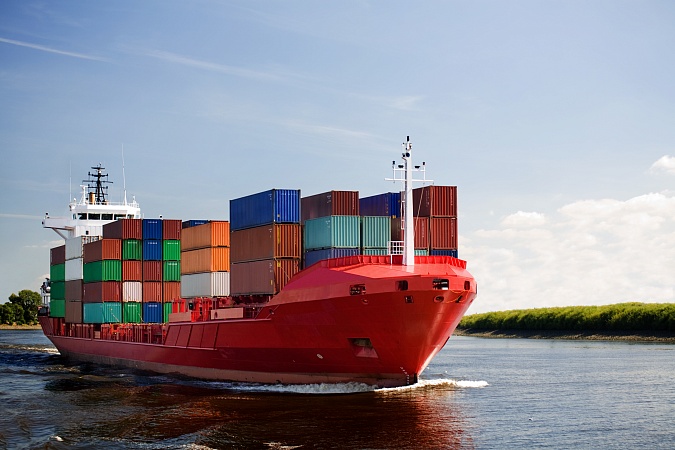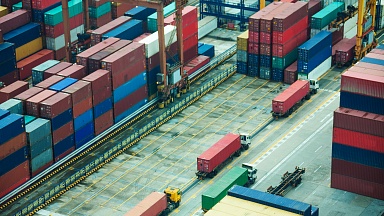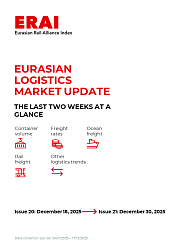The numbers are nowhere near as high as in southern California, where overnight data shows that 56 containerships were either anchored or in holding areas while waiting to enter Los Angeles or Long Beach. Nevertheless, at least 20 boxships heading towards Antwerp, Rotterdam, Hamburg, Felixstowe, or other major ports in the region have had to anchor in recent days until a berth has become available.
Several have been forced to stay outside Rotterdam, Europe’s largest port, where Kuehne+Nagel’s ocean freight intelligence platform Seaexplorer says there is “extreme yard congestion at several terminals”, with opening and closing times for cargo constantly changing, and trucks delayed at the port by one to three hours. Some terminals are refusing to accept empties.
Ships that have been caught up in the delays include the 18,270 teu Triple-E class Munkebo Maersk and the 20,150 teu Ever Glory.
Rotterdam is ranked number 10 in the world by Lloyd’s List in terms of box throughput, which totalled about 14m teu in the past year.
Nearby, Antwerp, the world’s 13th-largest container port, with 2020 volumes of 12m teu, is also heavily congested. Average vessel waiting time is currently about four to five days, according to Seaexplorer. This reflects severe trucking problems as well as container shortages including a lack of reefers boxes for some lines.
Vessels waiting to enter the Belgian port include the 19,000 teu CSCL Pacific Ocean, and the 23,800 teu HMM Oslo along with numerous smaller ships.
However, some of the vessels at anchor in northern Europe are far larger than those in San Pedro Bay waiting to berth, since the biggest ships regularly deployed on the transpacific trades are around 14,000 teu, with only occasional exceptions.
Seaexplorer shows that ports in northern Europe with the least congestion right now are Bremerhaven, DP World's London Gateway and Southampton facilities, and Wilhelmshaven. All have some disruption but not to the extent of others. Felixstowe, which has been in the headlines this week, remains severely congested, with stack density reaching 92%. That is way above the level needed for a smooth functioning yard.
Felixstowe challenges
Import dwell on the quay increased to 8.6 days at Felixstowe, according to Seaexplorer, with rail freight delays also reported. Off-dock storage locations are also clogged, with the lead time to shunt from port to depot between 10 and 14 days. On Thursday, both the 13,000 teu Maersk Edmonton and 2,870 teu Songa Puma were anchored outside the east of England port.
Elsewhere in the UK, both Liverpool and Immingham were described as heavily congested, while other ports with ships at anchor outside include Le Havre and Zeebrugge.
US congestion far worse
But Europe is not experiencing anything like the sort of congestion that has been seen in the US in recent months. This reflects both a steeper recovery in cargo volumes but also the different structure of the transpacific and Asia-Europe trades.
These are the largest in the world, with Container Trades Statistics data showing they were broadly equal prior to the coronavirus situation, with 16.1m teu moved from Asia to the US in 2019, and 16.7m teu from Asia to Europe.
But while volumes have remained broadly flat in the Far East-Europe trades in the first eight months of 2021 compared with 2019, at around 11.3m teu, US inbound cargo has rebounded very strongly from 10.7m teu to 13.3m teu over the same period.
The big challenge for the North American trades is the relatively few number of ports along the west coast, compared with the many alternatives in Europe.
The twin giants of Los Angeles and Long Beach handle a very large share of box traffic, but each terminal will also unload most of the cargo during one call, which creates bulges right along the supply chain. In Europe, big ships of up to 23,000 teu will berth at several ports, with less discharged per call.
There is also more flexibility in Europe to adjust schedules, as Maersk did when it skipped a Felixstowe call because of an over-crowded quayside. Instead, Maersk offloaded UK-bound cargo on the Continent for transhipment by feedership back to Britain.




